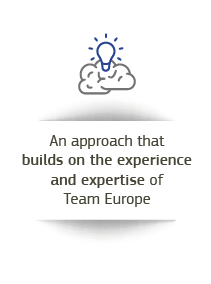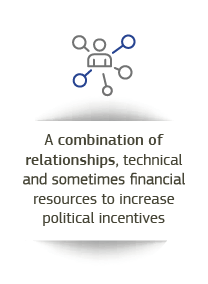14. A quick guide to joint implementation
Joint implementation, whether financial or non-financial, translates shared objectives into collaborative action by establishing arrangements for working together. The purpose is to maximise the impact of Team Europe’s collective expertise and resources. Joint implementation should produce more coherent, effective, efficient and coordinated support at country and regional level, thus contributing to greater impact.
What is joint implementation?
|
Image

|
Image

|
Image

|
Image

|
- Joint implementation is a direct response to the EU’s Global Strategy (2016) which recognises that ‘a strong Union is one that thinks strategically, shares a vision and acts together (…) We know what our principles, our interests and our priorities are (…) We will deliver on our citizens’ needs and make our partnerships work only if we act together, united.’
- The relationship between joint programming and joint implementation is mutually reinforcing. If joint programming is well designed, it establishes the preconditions for successful joint implementation. Similarly, effective joint implementation brings joint programming to life and demonstrates its value. However, both arrangements can also exist independently from one another.
- Joint implementation is an approach that builds on the experience and expertise of Team Europe to support sectoral activities that achieve results in line with partner countries’ development priorities. Joint implementation describes how the Member States work with each other as well as how the EU works jointly with MS.
- Joint implementation combines relationships, technical and sometimes financial resources to increase political incentives and the corresponding likelihood that results are achieved. What does joint implementation consist of?
What does joint implementation consist of?
|
Image

|
- Joint implementation involves a wide range of financial and non-financial ways of working together. It should cover all collaborative arrangements for implementation and all activities around it, including co-financing, delegated cooperation, coordination mechanisms, etc.
- It should offer increased efficiency and greater impact for both the beneficiary and the development actors.
- Joint implementation can contribute to awareness of the value added of joint programming, notably the value of having shared objectives in policy dialogue. It also can highlight what can be achieved through joint programming and contribute to policy dialogue, demonstrating joined-up action by European partners that draws on the range of tools and expertise collectively available.
- Joint implementation can exist in partner countries where there is no joint programming process in place. However, joint programming is an important facilitator for effective joint action.
What are the key characteristics of joint implementation?
Joint implementation delivers most benefits when it:
- is specific to the country context;
- can make effective links to other areas of European external action or priorities, and align with policy initiatives such as the Gender Action Plan, the CSO Roadmap, the Human Rights and Democracy Strategy and the Humanitarian-Development-Peace Nexus;
- combines various financial and non-financial modalities, making best use of the combined toolbox of the EU and MS;
- is based on the sharing and applying of best practices, experiences and networks at country/regional level;
- covers the entire project cycle;
- specifies the role and responsibilities of each partner during the whole project cycle, including for joint monitoring and joint evaluation processes; and
- allows unified communication partnerships outside the EU, ensuring that partner countries give recognition to the EU’s contribution and take a role in guaranteeing that the beneficial impact of the EU’s contribution is understood by the citizens that gain from it.
Each section or chapter may be used separately to fulfil a specific need for guidance, which means there may be some overlap between the different parts of the document.
If you have any questions, you may contact the relevant helpdesk or functional mailbox:
- JOINT-PROGRAMMING-SUPPORT@eeas.europa.eu
- INTPA-JOINT-PROGRAMMING-SUPPORT@ec.europa.eu
- NEAR-JOINT-PROGRAMMING@ec.europa.eu
Recent updates
